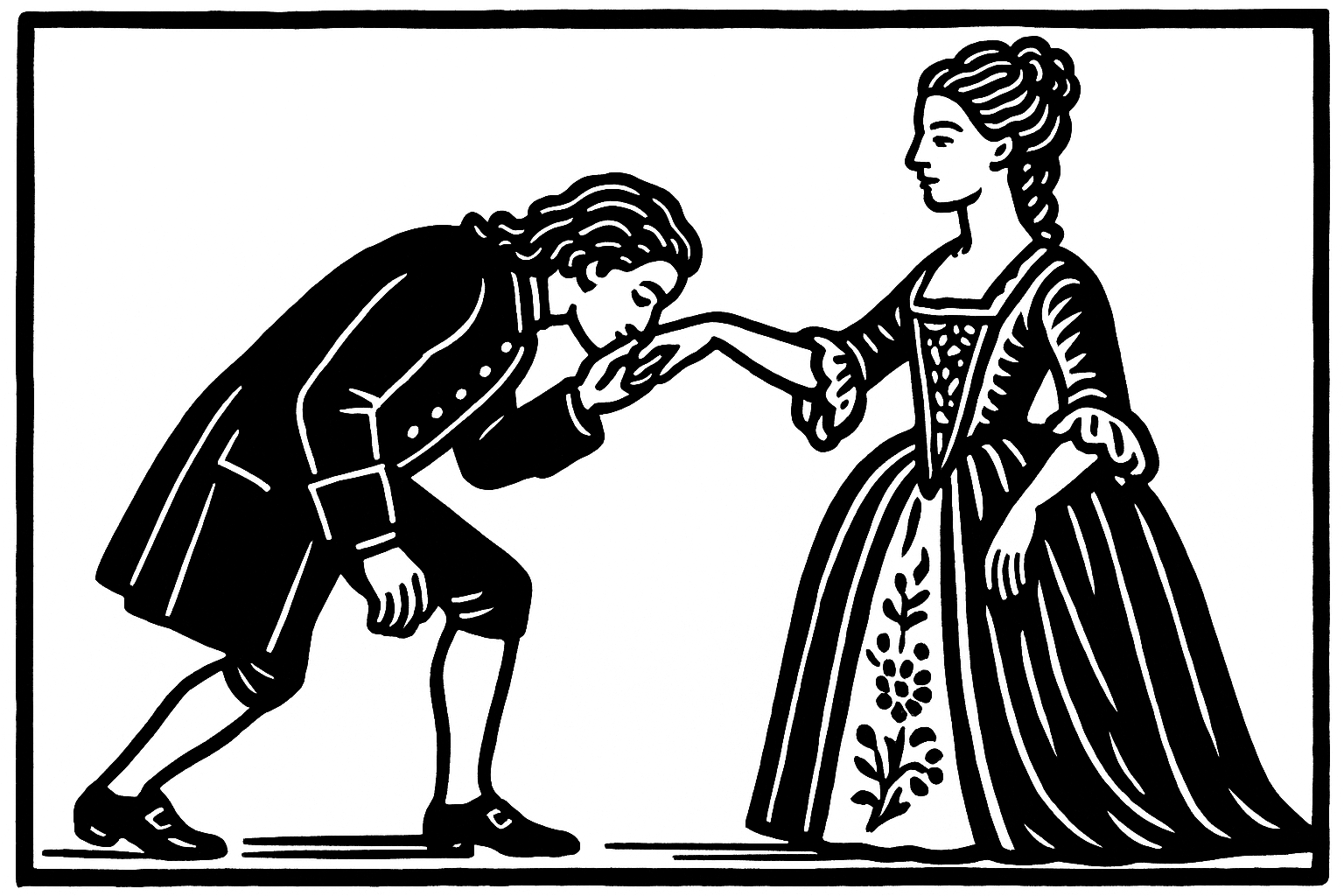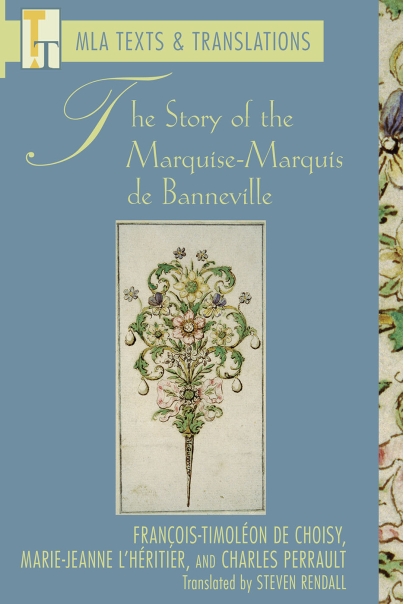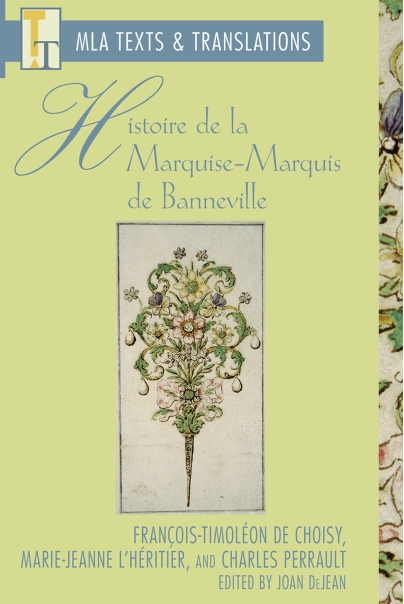Marquise-Marquis de Banneville
In my forthcoming historical novel, La Maupin, Mistress of the Sword, based on the life of Julie d’Aubigné, our heroine shocks and offends onlookers when in the midst of a ball thrown by Monsieur, the King’s brother, she kisses the belle of the ball while cross-dressed in a cavalier style. Three young men challenge her to a duel. As she exits to face them in the street below, it is suggested that she apologize, and she responds:
“You would have me apologize for my mode of dress? The Queen dressed Monsieur as a girl when he was a child—Abbé Choisy was raised in like manner, and is well known to dress as a woman. The King awarded the Order of St. Louis to a woman captain who wore the uniform coat of her rank over a woman’s gown. All of Paris read the story of the Marquise-Marquis de Banneville in the Mercure Galant this very year—a romance of travesty. And you would have me apologize for how I dress at one of Monsieur’s balls? Truly?”
All of the examples that I have her toss out are historical. Philippe d’Orléans, Abbé François-Timoléon de Choisy and Geneviève Prémoy a.k.a. “Chevalier Baltazar” were all historical figures famous or infamous for cross-dressing. But who or what was the Marquise-Marquis de Banneville? She was the fictional main character of a nouvelle—Histoire de la Marquise-Marquis de Banneville—that first appeared in the February 1695 issue of the Mercure Galant and in expanded form in the August and September 1696 issues. La Maupin calls it a “romance of travesty”. Today it might be called a transgender love story.
That story is tied to three interesting figures of the time. Charles Perrault was a writer and poet who, a year after the ball, would turn his focus to fairy tales with the publication of his famous Mother Goose tales. Marie-Jeanne L’Héritier de Villandon was his niece, an influential member of salon society and a writer who published her first fairy tale a year before her uncle. The third was Abbé Choisy, the cross-dressing churchman, scholar, and diplomatic envoy to Siam, who, using the names Comtesse des Barres and Madame de Sancy, hosted salons of his own.
The Histoire was published anonymously, but all three—Perrault, l’Héritier and Choisy—have been tied to it through the author’s introduction, comments by Mercure’s publisher, Jean Donneau de Visé, and published versions of their other works. It is quite likely that it was written by either Perrault and l’Héritier, or by all three, though for years it was credited to Choisy alone.

The story revolves around Mariane, the “little Marquise”, whose father died before she was born. Her mother, fearing to lose a son in like manner to her husband, instructed the midwife to say the child was a girl, no matter its actual sex. And so she raised her son as a girl. Even the little Marquise had no inkling that she was a boy. As she grew, she had a number of suitors, but rejected them all. Eventually, however, she fell in love with the Marquis de Bercourt, and he with her.
Knowing that her daughter could never marry the young man, the Marquise drove him away. This broke Mariane’s heart. She stopped eating, took to her bed, sickened and wasted away. Fearing her daughter would die, the Marquise sought out the young Marquis and begged him to visit the little Marquise’s bedside. He did, and she began to recover. As she did so, he became her constant companion. Time passed, and neither had an eye for anyone else.
Eventually, her mother broke down and told the little Marquise that she was in fact her son, not her daughter. For a time, that restrained Mariane and she contented herself with a platonic companion, but eventually she could endure it no more, and proposed marriage to the Marquis de Bercourt. He was reluctant and at first refused, content to maintain their brotherly/sisterly relationship. Her friends by then were making sport of her for being unmarried, and so she pressed her suit. The marquis took pity and agreed to marry her, but only publicly; they must remain forever chaste.
Knowing that they were both men, she agreed to his stipulation, anything to be with her beloved and to present themselves to the world as a contented couple. And so, it came about that they married. This actually pleased her uncle, who knew her secret, and knew that the couple would never provide an heir, allowing him to inherit her father’s title. On their wedding night, the Marquis de Bercourt confessed his secret, the reason that he was unwilling to marry her. You see, he was actually a young woman, who had cross-dressed her whole life. As two young women, they can never be truly wed. Ah! But, you see! That is perfect! Mariane revealed her secret to him.
Neither was comfortable dressing or comporting themselves as their birth sex, so they agreed to keep their secret and continue cross-dressing. After a short time, they retired to the country, where soon enough the Marquis de Bercourt became pregnant and bore a son, a son who could become the new Marquis de Banneville, much to the little Marquise’s uncle’s surprise. And, as with all such fairy tales, they lived happily ever after.
Available editions


For those interested in reading the story, the Modern Language Association of America (MLA) has both the original 1696 French and its English translation of Marquise-Marquis de Banneville in their bookstore (here or click on the appropriate image to the right).
The books each present the 1696 edition of the text along with a scholarly introduction discussing the possible authorship, the story’s history and its relationship to the lives and works of the three probable authors. They also include the material added for the 1723 edition in a pair of appendices.
Google Books has a copy of Volume 201 of Mercure de France from 1928 with a reprint of the story accompanying a discussion of the possibility that it is a collaboration between Perrault and Choisy.
Further Reading
In addition to the discussion of origins of Marquise-Marquis de Banneville published in Mercure de France, and the material in the introduction and prologues of the MLA editions, a few scholars and commentators on women's issues have published articles. Here are a couple:
This scholarly article from 1997 does an in-depth analysis of the Marquise-Marquis de Banneville both as a text in and of itself, and in relation to the childhood transvestism of Abbé Choisy and, to a lesser extent, Monsieur, Philippe d’Orléans.
The analysis in this article is very thorough in terms of cross-dressing, and male and female hetero- and homosexual roles and identities. But, due no doubt to being nearly three decades old, it does not address transgender roles or issues, mentioning neither transsexual nor transgender identities. This is not unreasonable, as that was less of a focus in the 1990s than in the 2020s, and those terms and concepts were quite foreign to the 1690s, when the story was written.
Still, this is an article well worth reading, though the reader should be warned that the author frequently quotes the text and other contemporaneous writings in French without translation.
By the time that this article was written, transgender issues had become more of a concern, and Marquise-Marquis de Banneville had come to be seen in that light. This article seeks to go beyond focusing on the protagonist’s identity to look at the question of the sorts of communities that build up around her and other gender-nonconforming characters. It looks both at the secondary characters in the tale and at the communities of creators and readers growing up around the Mercure Galant itself.
The Mercure started out as a women’s publication, and even after its readership expanded, addressed the reader as a woman when speaking in its editorial voice. And so, what I have Julie say—“All of Paris read the story of the Marquise-Marquis de Banneville in the Mercure Galant ”—is not really true. It was the elegant, fashionable, literary and artistic society that read Mercure. As such, the social mores and expectations of the readership and those writing and publishing to them represent a certain subculture or set of subcultures, and not Paris or France as a whole.
The story of the little Marquise ends with a heteronormative couple living a gender-nonconforming life, and doing so in a context that includes other gender-nonconforming and transgressive individuals. It presents this ending as echoing the “happily ever after” model of fairytales such as those that two of its probable authors would shortly become famous for.
This article explores many of these themes and trends.
Bonus Snippet: The Duel
Since I gave you a peek at the scene where Marquise-Marquis de Banneville was mentioned, here’s the full scene as La Maupin and her second, Florian Deschamps, step out of the Palais-Royal after she is challenged to a duel over kissing the beautiful marquise.
“Do you think this is wise?” asked Florian, as they made their way down the rue Saint-Thomas.
“Wise? Surely not. But it was they who made the challenge. What am I to do?”
He shrugged. “Nothing that suits your nature, nothing you are likely to do.”
“What would you do?”
“I might consider apologizing for anything tha–”
“Apologize? For what? For worshipping at the feet of beauty? For being who I am?”
“You do present a figure most interesting… unique, even.”
“Then, for being too strange?”
“For disrupting the ball, their lives.”
“Shattering their illusions, the well-worn ruts of their habits. No, I will not. This is the age of the modern. Art is changing. Also the rules. Shall Mme. d’Aulnoy and Saintonge cease writing because they disrupt? Must Monsieur, our host, be bound always by decorum? Lully disrupted tradition or we would have no Opéra! Pff! ”
They stopped under a street lamp to await the others.
When they had all arrived, Florian stepped forward.
“Gentlemen, are you still determined to engage in a duel of honor?”
“We are,” they all replied.
“Is there nothing short of a duel that will satisfy you?”
Jacques, the only second who was not, himself, a challenger, stepped forward. “My principal, the vicomte de La Haye, demands a public apology to the Marquise for the shocking display. Nothing less will satisfy.”
“Shocking?”
De La Haye, himself, stepped forward.
“But yes! From the outset, her perverse travesty was unacceptable—insulting to men and women alike. Then, to culminate with that disgraceful kiss. No, it was an offense to the lady herself, and to all that must endure the sight.”
“You would have me apologize for my mode of dress? The Queen dressed Monsieur as a girl when he was a child—Abbé Choisy was raised in like manner, and is well known to dress as a woman. The King awarded the Order of St. Louis to a woman captain who wore the uniform coat of her rank over a woman’s gown. All of Paris read the story of the Marquise-Marquis de Banneville in the Mercure Galant this very year—a romance of travesty. And you would have me apologize for how I dress at one of Monsieur’s balls? Truly?”
“Indeed. Monstrous and unnatural!”
“Yet it is natural to take up a sword against a woman! Well, sir—sirs—I once again accept your challenges.”
“Very well,” said Florian. “As I understand it, the first challenger will be Monsieur…?” He nodded to the one Julie had called “mon petit”.
“Morel. M. Morel,” replied that worthy.
“M. Morel, seconded by…” He looked to the student.
“Jean-Baptiste Brémond, at your service.”
“M. Morel, seconded by M. Brémond, challenging d’Aubigné, with Florian Deschamps as second. There being no neutral referee, I shall call, if that is acceptable?”
“Indeed,” replied Morel.
“Combatants, address one another.”
The two removed their justaucorps and waistcoats, then faced off, en garde, their swords barely touching.
At least for now, that’s where we’ll leave our story. The ball and the duel, of course, constitute a key point in the book, and I’m holding them close until they are in their final form.